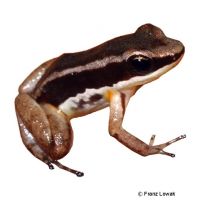Talamanca Rocket Frog (Allobates talamancae)
| Talamanca Rocket Frog Allobates talamancae | |
|---|---|
| Name | Talamanca Rocket Frog |
| Name Lat. | Allobates talamancae |
| Synonym | Colostethus talamancae |
| Family | Dendrobatids |
| Family lat. | Dendrobatidae |
| Order | Frogs & Toads |
| Order lat. | Anura |
| Origin | Central America |
| Habitat | Rainforest |
| Diet | Small live insects |
| Humidity | 70-100 % |
| Behavior | Territorial |
| Keeping | Pair |
| Care Level | Easy |
| Breeding | Moderately difficult |
| Housing | Rainforest terrarium |
| Life Span | 5-10 years |
| Protection | No |
| Metric Units | |
| Size | 2.5 cm |
| Temperature | 25-28 °C |
| Housing Size | 30 x 25 x 35 cm |
| US Units | |
| Size | 1" |
| Temperature | 77-82 °F |
| Housing Size | 10" x 10" x 15" |
Distribution and habitat
The range of the diurnal, ground-dwelling Talamanca Rocket Frogs extends from Costa Rica through Panama to northwestern Ecuador, along the Cordillera Talamanca. They live primarily in lowland rainforests up to 800 m elevation, usually near small streams, wet depressions, and lacustrine lakes. The coloration of the animals varies according to their origin
Maintenance
For 1-3 animals, the minimum terrarium area is 750 cm², with a minimum effective height (measured without substrate) of 25 cm. This corresponds to a base area of e.g. 30 x 25 cm. For each additional animal, provide an additional 200 cm² of surface area and 2.5 cm of height. The terrarium should be placed in a quiet place without sunlight.
You need a terrarium with a substrate of loose, absorbent, non-rotting substrate such as sand-peat mixture, coconut fibers or sphagnum moss with a drainage and a shallow, 3-5 cm deep watering place, in addition branched climbing branches, preferably entwined with climbing plants, with horizontal perches, back and side wall coverings of e.g.E.g. tree fern plates (Xaxim) and a dense planting (e.g. Tradescantia, Ficus, Scindapsus, ferns, Bromeliads). At least twice a day the inside of the terrarium must be finely sprayed with water (humidity), but a rain or mist system is better.
| Temp. day: 25-28 °C | Temp. night: 22-24 °C | Humidity: 70-100 |
The lighting duration must be 10-14 hours depending on the season. Daylight fluorescent tubes with low UV content are very suitable.
Diet
The food supply consists of live, small insects such as ants, spiders, micro crickets, tiny grasshoppers and crickets, springtails, enchytraea and drosophila. Food should be offered to adults 2-3 times per week, young animals must be fed daily. It is important to add minerals and vitamins regularly (e.g. by dusting the feed animals). The quality of the feed animals can be enhanced by feeding overripe fruit and honey water
A varied diet promotes health and prevents deficiency symptoms.
Reproduction and breeding
Males usually have a more intensely colored dorsolateral stripe and thus appear darker. The throat is colored dark gray or black in adult males, and white in juveniles and females. There is no difference in size between the sexes, females appear slightly more plump
The spawn, up to 25 eggs, is laid in a brood cavity (e.g., half coconut shell) where it is fertilized by the male. After 10-14 days at 22-24 °C the larvae hatch. The parents engage in brood care and drive away other frogs by jumping on them. The males carry each larva (tadpole) on their backs out of the breeding burrow into a small water body (e.g. leaf axils of bromeliads). After about 60-72 days the transformation (metamorphosis) is completed and the frog leaves the water. The breeding of the tadpoles in small plastic boxes filled with water has proven to be successful. They are fed with algae growth, dry fish food and chicken egg yolk.
Important
They do not possess skin toxin
Internally they behave very territorial, especially when feeding. Keeping several pairs is only recommended in a larger, richly structured terrarium.
Before purchasing, a terrarium should be prepared that meets the species specific needs. Good ventilation without drafts is necessary, as well as equipment for measuring temperature and humidity. The lighting has to correspond to the species-specific day-night rhythm and should be placed in such a way that the animals cannot injure themselves. The terrarium should be locked in such a way that neither unauthorized persons can open it nor the animals can escape. Special attention must be paid to thorough hygiene and impurities must be removed regularly.
Further literature can be found in your pet store.
References
Text: petdata; Image: Franz Lowak
Source: ENGELMANN (2006): Zootierhaltung - Tiere in menschlicher Obhut: Reptilien und Amphibien, Harri Deutsch Verlag; VDA & DGHT (2006): Haltungsrichtlinien für die Haltung von Anuren
- Gemäß § 21 Abs. 5 Tierschutzgesetz idgF
